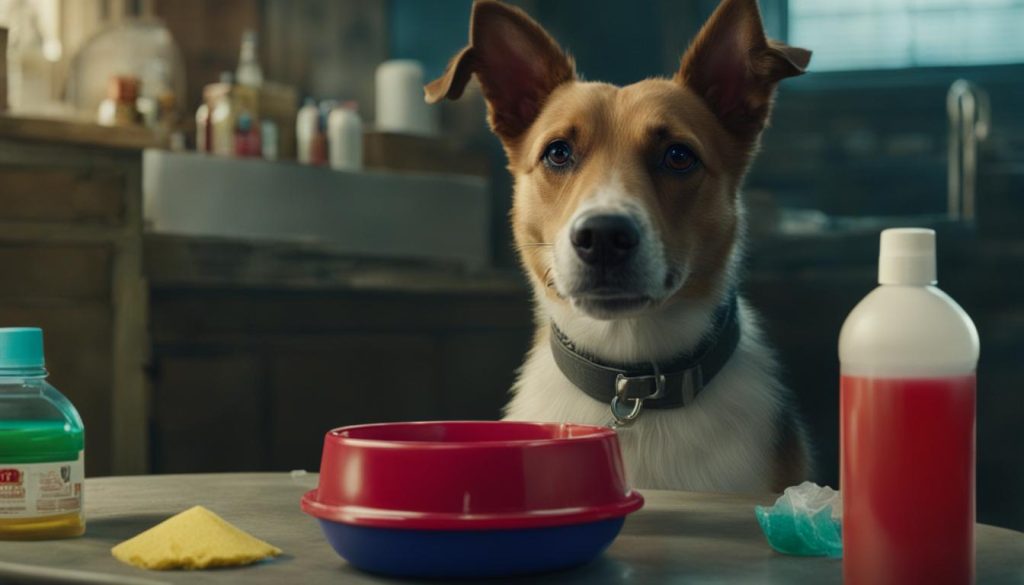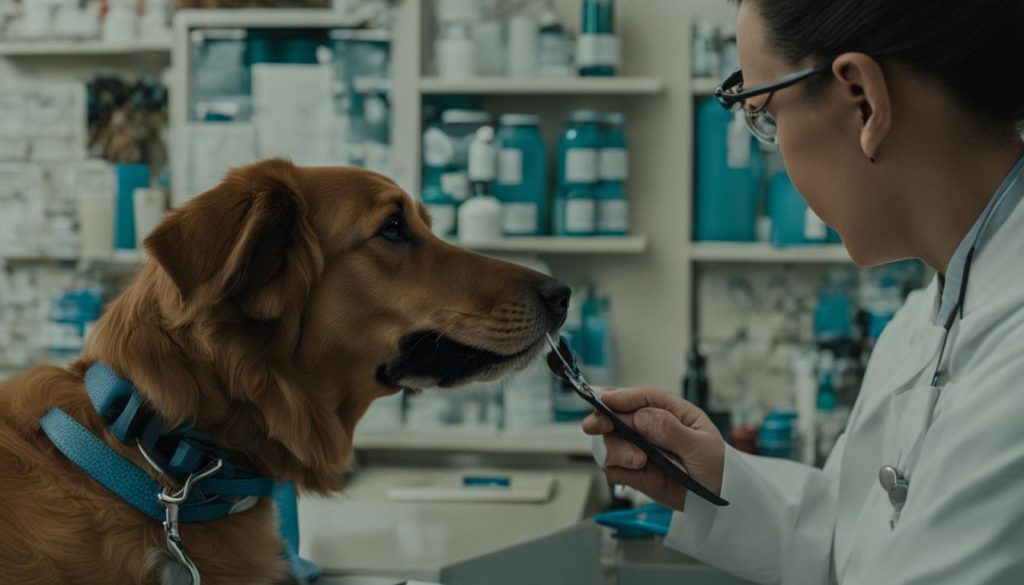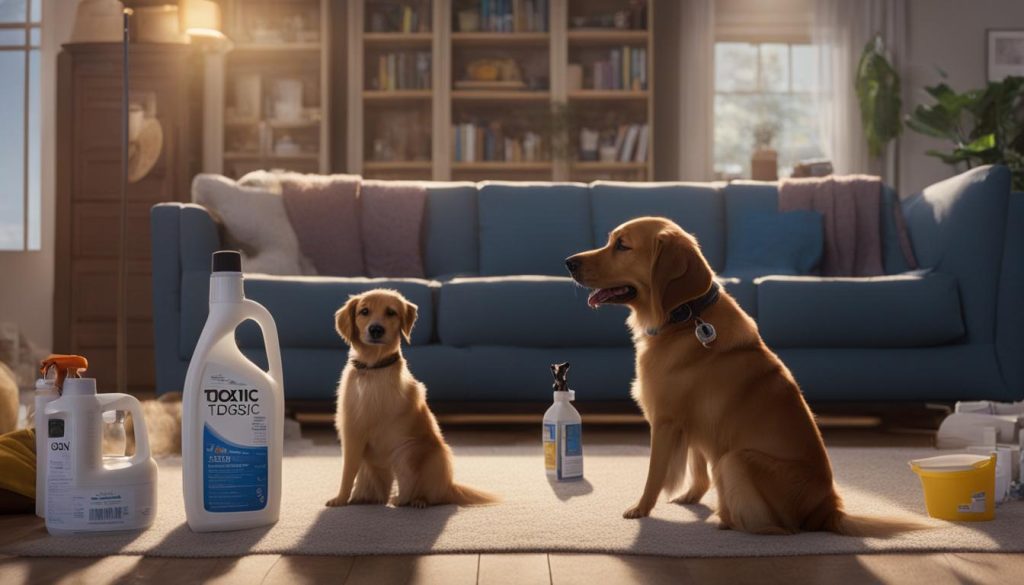Inducing vomiting in dogs can be a necessary step in certain emergency situations, especially when they have ingested something harmful. However, it is crucial to approach this process with caution and under the guidance of a veterinarian. Making a dog vomit should only be done under the supervision of a professional to avoid potential risks and complications.
Knowing when to make a dog vomit and when it is best to seek veterinary assistance is essential. Some objects or substances that dogs swallow can be dangerous if regurgitated, and the act of inducing vomiting itself comes with risks. It is important to understand the circumstances in which inducing vomiting in a dog is appropriate and when it should be avoided.
Key Takeaways:
- Inducing vomiting in dogs should only be done under the guidance of a veterinarian.
- It is important to know when to make a dog vomit and when to seek veterinary assistance.
- Inducing vomiting should be avoided if a dog has ingested hazardous substances or has certain health conditions.
- Hydrogen peroxide can be used to induce vomiting in dogs, but it should be used with caution and under veterinary guidance.
- In emergency situations, there are safe at-home methods to induce vomiting in dogs, but consulting a veterinarian is always recommended.
When to (or Not to) Make a Dog Throw Up
Knowing when to make a dog throw up is crucial for their well-being. While inducing vomiting can be necessary in certain situations, such as when a dog ingests potentially harmful substances, it is important to understand the circumstances in which it is appropriate and when it should be avoided. Making a dog vomit should only be done under the guidance of a veterinarian to ensure the safety of your furry friend.
When to make a dog throw up:
- If a dog ingests substances that are toxic or potentially harmful, such as certain foods, medications, or chemicals.
- When the ingestion occurred within the past two hours. It is best to act quickly to minimize the absorption and potential damage caused by the harmful substance.
When not to make a dog throw up:
- If a dog has ingested sharp objects, corrosive substances, or substances that could cause further damage or injury if regurgitated. In these cases, inducing vomiting can do more harm than good.
- If a dog is already vomiting, experiencing severe symptoms, or has health conditions such as breathing difficulties or recent surgeries. It is best to seek veterinary assistance in these situations.
“Inducing vomiting in dogs should be done with caution. Some objects or substances can be dangerous if regurgitated, and the act of inducing vomiting itself comes with risks.”
Remember, always consult with a veterinarian before attempting to make your dog vomit. They can provide personalized advice based on your dog’s specific circumstances and health condition. Additionally, they can help determine if inducing vomiting is necessary or if alternative treatments or interventions are more appropriate. Prioritizing veterinary guidance ensures the safety and well-being of your beloved pet.
Dangers of Inducing Vomiting in Dogs

Inducing vomiting in dogs can be a useful method in certain emergency situations, but it is important to be aware of the potential dangers and risks involved. Not all cases of ingestion require vomiting, and there are specific circumstances where inducing vomiting can be more harmful than beneficial.
One of the primary dangers of inducing vomiting in dogs is the risk of aspiration. When a dog forcefully vomits, there is a chance that stomach contents can be aspirated into the lungs, leading to aspiration pneumonia. This risk is particularly high if the dog has ingested a corrosive substance or if they have an underlying respiratory condition.
Additionally, certain ingested materials can pose a threat if regurgitated. For example, sharp objects can damage the esophagus or gastrointestinal tract during the vomiting process. Ingested chemicals, such as those found in household cleaning products, can cause further damage to the dog’s system if they are vomited back up.
| Dangers of Inducing Vomiting in Dogs |
|---|
| Aspiration pneumonia |
| Risk of damage from sharp objects |
| Further harm from ingested chemicals |
It is crucial to exercise caution and consult a veterinarian before attempting to induce vomiting in your dog. The veterinarian can assess the specific situation, provide guidance, and determine if vomiting is the appropriate course of action. They can also advise on any potential risks or complications based on the dog’s health status and the nature of the ingested substance.
It is important to remember that inducing vomiting should not be done without professional guidance. The risks involved, such as aspiration pneumonia and damage from ingested objects or chemicals, can outweigh the potential benefits. Always consult a veterinarian for proper evaluation and guidance.
Ensuring the safety and well-being of your dog is paramount, and seeking veterinary assistance in these situations is essential. The veterinarian can provide the necessary expertise and support to navigate the complexities of inducing vomiting and help mitigate any potential dangers or risks.
Summarized Points:
- Inducing vomiting in dogs can be risky and should only be done under veterinary guidance.
- Risks include aspiration pneumonia, damage from sharp objects, and further harm from ingested chemicals.
- Consulting a veterinarian is crucial to assess the situation and determine the appropriate course of action.
Using Hydrogen Peroxide to Induce Vomiting in Dogs

When it comes to inducing vomiting in dogs, hydrogen peroxide is a commonly used method. A 3% hydrogen peroxide solution can be administered orally to make a dog vomit. It is important, however, to consult with a veterinarian before using this method, as they can provide guidance specific to your dog’s situation.
Before administering hydrogen peroxide, it is crucial to determine the appropriate dosage based on your dog’s weight. Your veterinarian can provide you with the correct dosage and detailed instructions on how to safely administer it. It is important to create a calm and comfortable environment for your dog during the process, helping to minimize stress and anxiety.
“Administering hydrogen peroxide to induce vomiting in dogs should only be done under veterinary guidance to ensure the safety and well-being of the dog.”
It is important to note that hydrogen peroxide should not be used in certain situations. If your dog is already vomiting or is experiencing severe symptoms, do not attempt to induce vomiting at home. Instead, seek immediate veterinary care. Additionally, if your dog has ingested corrosive substances, sharp objects, or has underlying health conditions such as breathing difficulties or recent surgeries, do not use hydrogen peroxide without consulting with a veterinarian.
Remember, the use of hydrogen peroxide to induce vomiting in dogs should always be done under veterinary guidance. They can assess the situation, provide appropriate advice, and ensure the safety of your furry friend.
Table: Dosage of Hydrogen Peroxide for Inducing Vomiting in Dogs
| Weight of Dog | Amount of 3% Hydrogen Peroxide |
|---|---|
| 0-10 pounds | 1-2 teaspoons |
| 10-30 pounds | 1-2 tablespoons |
| 30-45 pounds | 2-3 tablespoons |
| 45 pounds and above | 3-4 tablespoons |
Safe At-Home Methods to Induce Vomiting in Emergencies
In some emergency situations, when immediate action is necessary and veterinary guidance is not available, there are safe at-home methods to induce vomiting in dogs. These methods should only be used as a last resort and under specific circumstances. It is important to consult a veterinarian before attempting to induce vomiting at home.
One safe method to induce vomiting in dogs is by using hydrogen peroxide. A 3% hydrogen peroxide solution can be administered orally, following the recommended dosage based on the dog’s weight. It is crucial to carefully follow the instructions provided by the veterinarian and to avoid using hydrogen peroxide in certain situations, such as when a dog is already vomiting or experiencing severe symptoms.
Another method that can be used in emergencies is the use of salt. However, this method should be used with caution and under the guidance of a veterinarian, as excessive amounts of salt can be harmful to dogs. Baking soda is also occasionally used, but it is important to note that this method may not be as effective as hydrogen peroxide.
Precautions when using at-home methods:
- Consult a veterinarian before attempting to induce vomiting at home.
- Follow the recommended dosage or instructions provided by the veterinarian.
- Ensure the dog is in a safe and comfortable environment.
- Monitor the dog closely during and after the process.
- Seek immediate veterinary care if any complications or adverse reactions occur.
It is important to remember that while these at-home methods can be effective in certain situations, they should only be used under emergency circumstances and with guidance from a veterinarian. Consulting a veterinarian is always the best course of action to ensure the safety and well-being of your dog.
| At-Home Method | Safety Rating | Efficacy |
|---|---|---|
| Hydrogen Peroxide | High | Effective for most cases |
| Salt | Low | Potentially harmful in excessive amounts |
| Baking Soda | Moderate | Less effective than hydrogen peroxide |
The Importance of Consulting a Veterinarian

When it comes to dealing with a dog vomiting situation, it is essential to consult a veterinarian. Veterinary guidance plays a crucial role in ensuring the well-being and safety of your pet. A veterinarian can provide personalized advice based on your dog’s specific circumstances and health condition, guiding you through the process of inducing vomiting if necessary.
By consulting a veterinarian, you can determine whether making your dog vomit is the appropriate course of action. They can assess the risks involved, considering factors such as the ingested substance, the dog’s health, and any pre-existing conditions. Additionally, a veterinarian can provide alternative treatment options if inducing vomiting is not recommended.
Veterinary guidance is especially crucial in emergency situations when you’re unsure whether the ingested substance is dangerous. A veterinarian can assess the potential risks and provide guidance accordingly. It is important to provide the veterinarian with all relevant information, such as the substance ingested, its quantity, and any symptoms or changes in your dog’s behavior.
When it comes to your pet’s health, consulting a veterinarian is always the best course of action. They can provide you with expert advice, ensuring the safety and well-being of your dog. Remember, the importance of veterinary guidance cannot be overstated when dealing with a dog vomiting situation.
Table: Benefits of Consulting a Veterinarian for Dog Vomiting
| Benefits | Explanation |
|---|---|
| Expert Advice | A veterinarian can provide accurate and personalized advice based on your dog’s specific circumstances and health condition. |
| Risk Assessment | A veterinarian can assess the risks involved in inducing vomiting, considering factors such as the ingested substance and the dog’s health. |
| Alternative Treatments | If inducing vomiting is not recommended, a veterinarian can provide alternative treatment options to ensure your dog’s well-being. |
| Emergency Situations | In uncertain situations where the ingested substance may be dangerous, a veterinarian can assess the potential risks and provide guidance. |
| Comprehensive Care | Consulting a veterinarian ensures comprehensive care for your dog, addressing any underlying health concerns and providing appropriate treatment. |
What to Do If You’re Unsure if the Ingested Substance is Dangerous

If you find yourself in a situation where your dog has ingested a substance and you’re unsure if it is dangerous, it is important to consult a veterinarian immediately. Their expertise and guidance can help determine the potential risks and necessary steps to ensure your dog’s health and safety.
When contacting the veterinarian, provide them with as much information as possible about the ingested substance, including its name, quantity, and any packaging or labeling details available. This information will assist the veterinarian in assessing the potential danger and providing appropriate advice.
Additionally, it is crucial to observe your dog for any symptoms or changes in behavior. Take note of any vomiting, diarrhea, lethargy, difficulty breathing, or other unusual signs that may indicate a problem. Sharing these observations with the veterinarian will help them better understand the situation and make an informed decision regarding the need for inducing vomiting.
Remember, it is always better to err on the side of caution and consult a professional. Veterinarians have the knowledge and experience to evaluate the situation and determine the best course of action for your dog’s well-being.
Table: Signs of Potential Danger
| Signs of Potential Danger | Action |
|---|---|
| Vomiting | Consult a veterinarian immediately |
| Diarrhea | Consult a veterinarian immediately |
| Lethargy | Consult a veterinarian immediately |
| Difficulty breathing | Consult a veterinarian immediately |
| Unusual behavior | Consult a veterinarian immediately |
If any of these signs are present, it is important to seek veterinary assistance promptly. Your veterinarian will be able to provide the necessary guidance and help determine the best course of action to ensure your dog’s health and safety.
Safety Tips and Precautions for Inducing Vomiting in Dogs

When it comes to inducing vomiting in dogs, it is essential to prioritize their safety and well-being. Here are some important safety tips and precautions to keep in mind:
- Consult with a veterinarian: Before attempting to induce vomiting in your dog, it is crucial to consult with a veterinarian. They can provide personalized advice based on your dog’s specific circumstances and health condition, guiding you through the process and ensuring the best course of action.
- Stay calm and gentle: Creating a calm and stress-free environment is important when inducing vomiting in dogs. Speak softly and use soothing gestures to keep your dog relaxed during the process, minimizing any potential distress.
- Monitor your dog afterwards: After inducing vomiting, it is important to closely monitor your dog. Keep an eye on their behavior, appetite, and overall well-being. If you notice any unusual symptoms, such as persistent vomiting, lethargy, or difficulty breathing, seek immediate veterinary care.
- Ensure access to fresh water: Vomiting can lead to dehydration, so it is crucial to provide your dog with access to fresh water after the process. Hydration is key to their recovery and overall health.
By following these safety tips and precautions, you can help ensure a smooth and successful process when inducing vomiting in dogs. Remember, always consult with a veterinarian for personalized guidance and support.
Quote:
“Creating a calm and stress-free environment is important when inducing vomiting in dogs.”
Timing and Next Steps After Inducing Vomiting in Dogs

Timing is crucial when it comes to inducing vomiting in dogs. If your dog has ingested certain substances like antifreeze, chocolate, grapes, or medication, it is recommended to act quickly within the first 2 hours. This timeframe allows for the highest chance of successful vomiting and minimizing the absorption of harmful toxins into the body. However, it is important to note that this is a general guideline, and the specific circumstances may vary. Consulting a veterinarian is always advised to ensure the best course of action for your dog’s situation.
After inducing vomiting in your dog, the next steps are equally important. It is essential to closely monitor your dog for any signs of distress or complications. Keep a watchful eye on their behavior, breathing, and overall well-being. If you notice any unusual symptoms or if your dog’s condition worsens, it is imperative to seek immediate veterinary care.
Additionally, follow-up veterinary care is necessary after inducing vomiting in your dog. A veterinarian can provide further evaluation and determine if any additional treatments or interventions are required. They may perform further tests, administer supportive treatments, or suggest specific dietary adjustments to aid in your dog’s recovery. Veterinary guidance is essential to ensure the safety and well-being of your furry companion.
Summary of Timing and Next Steps:
- Act quickly within the first 2 hours if your dog has ingested antifreeze, chocolate, grapes, or medication.
- Consult a veterinarian to determine the best course of action for your dog’s specific situation.
- Monitor your dog closely for any signs of distress or complications.
- Seek immediate veterinary care if you notice any unusual symptoms or if your dog’s condition worsens.
- Follow up with a veterinarian for further evaluation and potential additional treatments.
Remember, the information provided here serves as a general guide but does not replace professional veterinary advice. Each dog’s situation is unique, and it is essential to consult with a veterinarian to ensure the best care and outcome for your beloved pet.
Wrapping Up
To summarize, the safe and appropriate induction of vomiting in dogs is an essential skill for pet owners to possess in certain emergency situations. However, it is crucial to approach this process with caution and under the guidance of a qualified veterinarian. By understanding the risks involved, following proper procedures, and seeking veterinary advice, you can ensure the safety and well-being of your beloved pet.
Remember, always prioritize consultation with a veterinarian to make informed decisions regarding your dog’s health. They can provide accurate and personalized guidance based on your dog’s specific circumstances and health condition. Their expertise will help you determine whether inducing vomiting is necessary and guide you through the process, ensuring the best possible outcome for your furry friend.
In summary, this comprehensive guide has provided important insights into when to make a dog vomit, the dangers of inducing vomiting, safe at-home methods, the importance of consulting a veterinarian, what to do when unsure about the ingested substance, safety tips and precautions, timing, and next steps after inducing vomiting in dogs. By following these guidelines and seeking professional advice, you can effectively respond to emergency situations and provide the necessary care for your dog’s well-being.
FAQ
When is it appropriate to induce vomiting in a dog?
It is appropriate to induce vomiting in a dog when they have ingested something harmful, under the guidance of a veterinarian.
Are there any dangers or risks associated with inducing vomiting in dogs?
Yes, inducing vomiting in dogs can be harmful if certain substances or health conditions are present. It is important to seek veterinary guidance to avoid potential risks and complications.
How can hydrogen peroxide be used to induce vomiting in dogs?
A 3% hydrogen peroxide solution can be administered orally to make a dog vomit, but it is important to consult a veterinarian before using it and to follow the recommended dosage.
What are the safe at-home methods to induce vomiting in emergencies?
Safe at-home methods include using hydrogen peroxide, salt, and baking soda. However, it is always recommended to consult a veterinarian before attempting to induce vomiting at home.
Why is it important to consult a veterinarian when inducing vomiting in dogs?
Consulting a veterinarian ensures accurate advice based on the dog’s specific circumstances, guidance through the process, and other supportive treatments if needed.
What should I do if I’m unsure whether the ingested substance is dangerous for my dog?
It is important to consult a veterinarian who can assess the potential risks and provide guidance based on the ingested substance and the dog’s symptoms or changes in behavior.
What safety tips and precautions should I follow when inducing vomiting in dogs?
Safety tips include consulting with a veterinarian, staying calm, monitoring the dog afterwards, ensuring access to fresh water, and seeking immediate veterinary care if complications occur.
What should I do after inducing vomiting in my dog?
It is important to monitor the dog closely and seek follow-up veterinary care as soon as possible. Additional treatments or interventions may be necessary.






